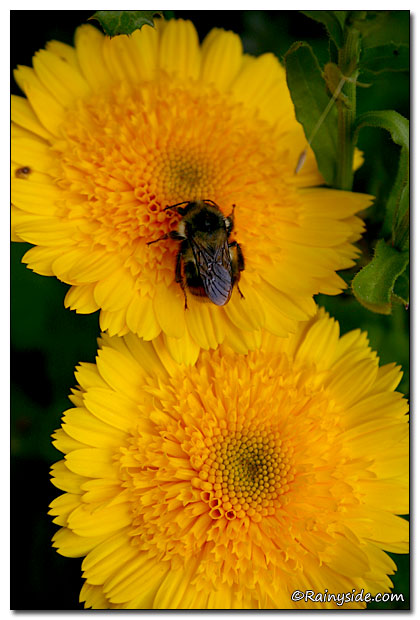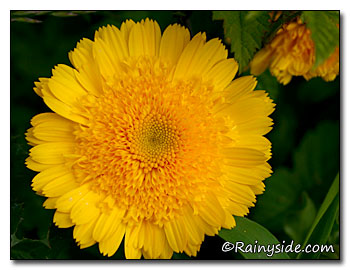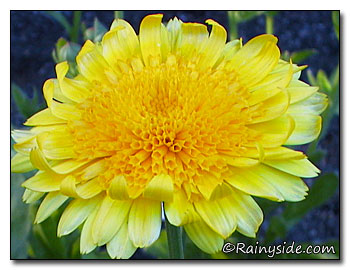Calendula officinalis 'Citrus Smoothies'
ENGLISH MARIGOLD, POT MARIGOLD
Family: Asteraceae
Pronounced: kal-END-yew-la o-fih-shih-NA-lis

Quick Jumps
Growing Guide
Rainy Side Notes
GROWING GUIDE

Origin:
Garden.
Plant Group:
Annuals.
Mature size:
Height: 20-24 inches (50-64 cm).
Width: 12-18 inches (30-75 cm).
Flowering period:
Summer into fall.
Flowering attributes:
A mix of colors from apricot to yellow. Daisy-like flowers can reach sizes up to 4 inches across.
Leaf attributes:
Lance to spoon-shaped, fragrant, green leaves.
Light:
Full sun to partial shade.
Soil:
Well-drained, moderately fertile soil.
Feeding:
Add a complete organic fertilizer when planting.
Propagation Methods:
Sow outdoors in spring ½ inch deep in well-cultivated soil . For earlier flowers, sow seed in pots in February in a cool greenhouse At 70°F (21°C), germination takes 10 to 14 days. Cover seed well. Calendula seeds germinate better without light.
Pests and Diseases:
Rust, gray mold, cucumber mosaic virus, powdery mildew, aphids and whiteflies might be a problem, but I have yet to see the preceding list of diseases or pests in my Northwest garden. Protect young plants from slugs and snails until the plants are well established.
Rainy Side Notes


Calendulas are bright, colorful, choice annuals for the border, vegetable, or cutting garden. These pot marigolds thrive in mild climates, making them perfectly suitable for the maritime Pacific Northwest. If properly hardened off with at least a week of 40°F (4°C) temperatures, the plants can then tolerate light freezes.
Continually deadheading the blossoms to keep them from producing seed prolongs the flowering season. 'Citrus Smoothies' is a mix of colorful pot marigolds selected for their large flowers with hues of lemon yellow to apricot. This annual has been a long time favorite of vegetable and ornamental gardeners. The plant is great for attracting armies of beneficial insects, which help pollinate fruit crops and keep many pests under control, important qualities for those of us who do not use pesticides in our gardens. The Wild Seed catalog has the perfect description about why Calandulas are advantageous to the pesticide free garden. “In the field, blooms encourage a host of beneficial insects: minute pirate bugs for thrip control, syrphids for aphids, micro-wasps that parasitize aphids and caterpillars, and native fruit-pollinating solitary bees.”
Centuries after the Romans named the plant Calendula, Linnaeus recorded it as the same thereby making the title official. Romans observed that many of the species flowered regularly, or as they called it, "in the calends”—calend meaning the first days of a Roman month. In Mexico, it was called the flower of death, as it would spring up in disturbed areas after a war. Although no longer in use, Jackanapes-on-horseback was another one of this annual's common names. Pot marigolds or English marigolds as they are sometimes called, should not be confused with true marigolds—the Tagetes species and hybrids.
During the seventeenth century, the plant was used as treatment for jaundice, measles, and small pox—only because the flower was yellow! Romans used the flowers to cure warts. Today lotions are made from the flowers and used as a salve for everything from cuts to diaper rashes. The flower petals are edible in small quantities, and are used fresh as garnish in salads or other food applications. Be careful to eat only a small measure, as ingesting large amounts can be harmful.
Debbie Teashon
Photographed in author's garden.

Gardening for the Homebrewer: Grow and Process Plants for Making Beer, Wine, Gruit, Cider, Perry, and More
By co-authors Debbie Teashon (Rainy Side Gardeners) and Wendy Tweton
Copyright Notice | Home | Search | Annuals

